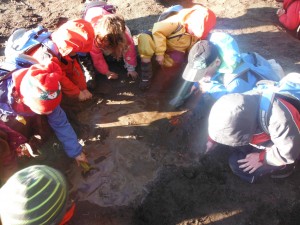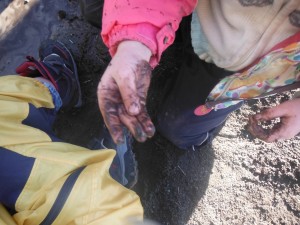 More rain brought many more worms which lead to counting and exploring the wonderful world of worms more in depth! When it rains we have noticed many worms on our trail and in our site. We have been
More rain brought many more worms which lead to counting and exploring the wonderful world of worms more in depth! When it rains we have noticed many worms on our trail and in our site. We have been  learning lots about worms such as what and how they eat, where they life, and how old they can grow and the names of their body parts. After a book and discussion about all about worms, the children set out to discover and find them on the field and in the sand pit. As the children explored the ground for worms, they noticed the many differences between worms. “Some are fat and come are skinny” a child reported. Other children reported that the best place to find worms were in “soft soil and sand”. Some children created homes for the worms incase it rains and another group created a boat for worms so they could sail the river and not drown! What amazing problems solvers they are. After spending some time exploring the worms they chose one to interview. With a clip board, pencil and measuring tape the children discovered how long and old the worms were. Many drew or traced the worms and wrote down the word “saddle” (the middle bump of the worm that holds the eggs) as well as the age of the worm.
learning lots about worms such as what and how they eat, where they life, and how old they can grow and the names of their body parts. After a book and discussion about all about worms, the children set out to discover and find them on the field and in the sand pit. As the children explored the ground for worms, they noticed the many differences between worms. “Some are fat and come are skinny” a child reported. Other children reported that the best place to find worms were in “soft soil and sand”. Some children created homes for the worms incase it rains and another group created a boat for worms so they could sail the river and not drown! What amazing problems solvers they are. After spending some time exploring the worms they chose one to interview. With a clip board, pencil and measuring tape the children discovered how long and old the worms were. Many drew or traced the worms and wrote down the word “saddle” (the middle bump of the worm that holds the eggs) as well as the age of the worm.
The next day, Ms. Lockerbie introduced our new classroom worm compost! We had been saving our fruits and vegetables to feed to them. The best part is that the worm play didn’t stop there! For many days later the children, during play time dug for worms at our site as well! They figured out that any worms they collected should go into our compost bag! They also found out that is was sometimes difficult to get them out of the ground because their bodies anchored in. For the rest of the week the children counted, named, spelled and measured worms. They created conclusions about previous assumptions they had about what it was like to be a worm and discussed their findings with their classmates. These discussions lead them to discovering that worms hibernate! From there we introduced and discussed what other types of creatures hibernate… and that leads into our next week of learning and exploring.
The children’s ability to gather and retain facts on any subject of interest is remarkable. The most amazing part is that you provide them with these facts, ideas or questions and then they come in with their own. Then with ease and excitement they then get to see firsthand the life cycle of a worm, where the eggs are kept and which side is the head. They have the opportunity to notice where worms live and when you see them more. They are able to hold in their hand a small worm and a large fat one. The facts are then tangible and become alive in their hand.






